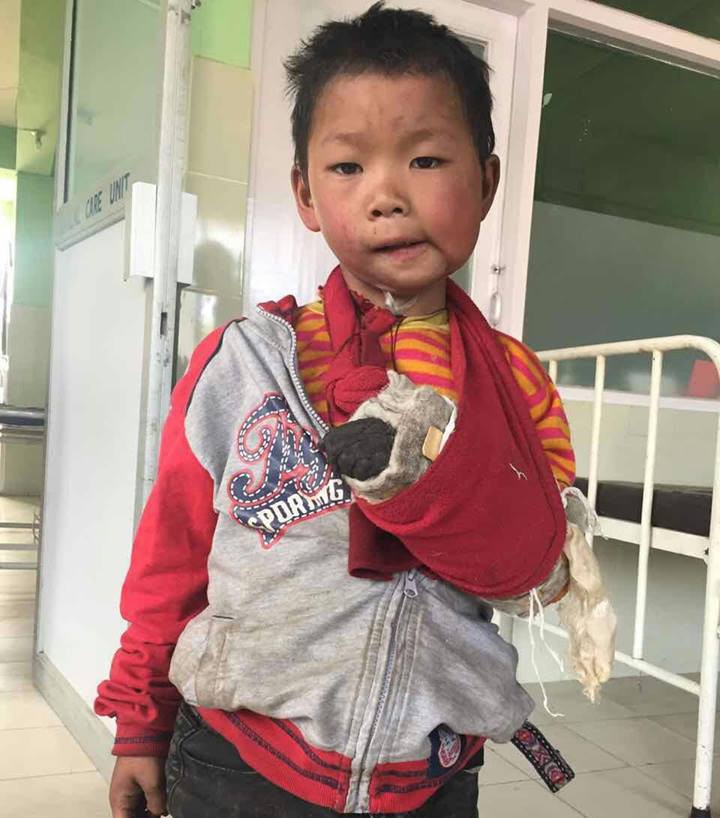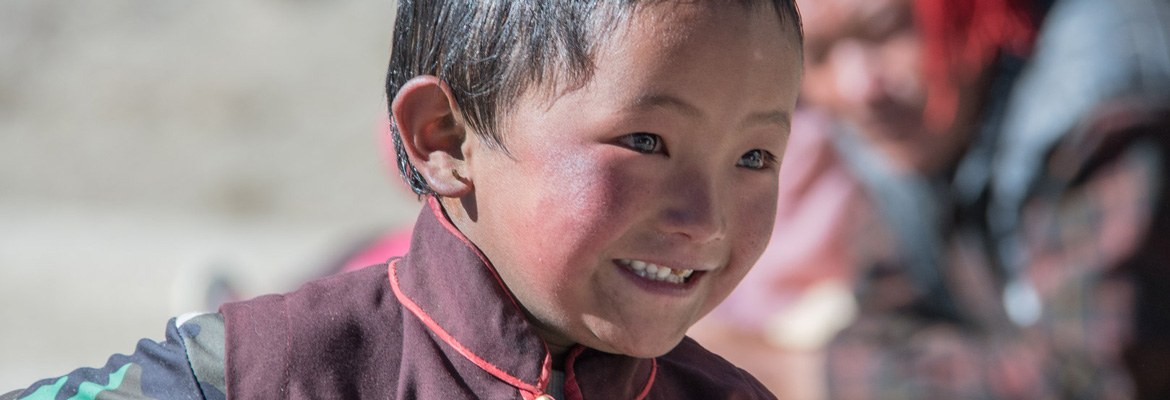
Our 2019 Goal was $40,000!
What will $40,000 accomplish?
Not enough!
I’ve just returned from Nepal and during the last week – “the week of many meetings”, I learned so much more about the issues in the Upper Dolpo related not only to education but also health, sanitation and medical needs that it is appropriate to use a quote by Yogi Berra “when you find a fork in the road – take it”. As absurd as that statement is, it is appropriate for the current situation.
Our priority for 2019 is still to ensure the operations of all the schools are fully supported; teacher salaries, books, stationary, school uniforms, food, supplies, critical repairs etc.
With so much need in the Upper Dolpo we realize that setting an annual fundraising goal, except to meet minimum school funding requirements, is no longer a viable strategy. It is critical that we begin to meet challenges in areas of public health and improved medical care access. Water and sanitation-related diseases are some of the primary reasons children don’t make it to their fifth birthday. Our initial goal for this work, with the local community and ENPHO, will be to provide safe water infrastructure to the school at Saldang. It has the most students and the largest population.
Read our Update – March 2019 thank you newsletter
Read our Update – February 2019 newsletter
Read our Update – December 2018 newsletter.
Read our Update – Progress on Fundraising for 2019 School Year newsletter.
Read our Request for Support for the 2019 School Year newsletter.
Read our August 2018 update newsletter.
2019 Projects in Brief
Health
Nurses from the Upper Dolpo and public health specialists maintain that at least 50% of the Dolpo’s health problems are related to contaminated drinking water. Many get sick with vomiting and diarrhea, especially during the rainy season when water from the hillsides, littered with dung, collects in the water courses. Diarrhea killed a five-year-old child at Saldang this summer and one project teacher came perilously close to death. Even after infusing four bags of saline the nurse was still not sure the teacher would survive the night.
We have begun work with ENPHO, (Environment and Public Health Organization). They are a NGO that specializes in the “WASH” program (water purification, sanitation – compost toilets and general hygiene practices). WASH was started by CAWST, a Canadian NGO. Both NGOs work with people in impoverished areas; they are experts in providing cost effective, simple technologies for access to safe drinking water, compost toilets and hygiene.
Clean water really does save lives.
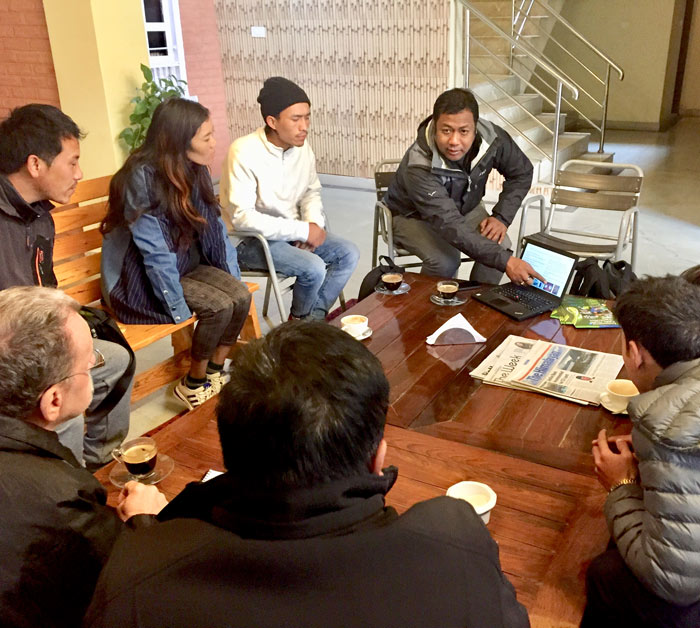
Bipin Dangol, Executive Director, met with us to introduce ENPHO programs to school coordinators
Medical
The health posts at Namdo, Saldang and Karang provide very basic care. They are closed in the winter, the time of year when people get very sick! Very treatable diseases and injuries can be life altering, or life ending. (Watch our short video, Jigme’s Hand.)
The infant mortality rate is ~50% here and ~25% of mothers die during childbirth. There is an amazing hospital at Bhejir (funded by American and Swiss donors) but patients must cross a 5,000+ meter pass to get there – not an easy task even when healthy! A long-term goal is to create a similar small-scale hospital at either Saldang or Karang that could provide a higher level of health care with basic testing like blood chemistry and ultrasound. I was pleasantly surprised to learn that the annual budget of the hospital at Bhejir is only $35,000 US. Last year they treated ~1,000 patients.
Most nurses in the Upper Dolpo are originally from this region and have returned to help their villages. Tashi Bhuti Lama, originally from Bhejir, decided to become a nurse at age 3 when she witnessed her mother’s death during childbirth. Now 29 years-old, she is a shining example of how education in the Dolpo helps their communities.
Saldang School
$8,000 for the school at Saldang, the school where Altitude Project started! We work in conjunction with a German non-profit, Freunde Nepal, to support this school.
Saldang will require support for general operations of the school and we will determine the exact portions of the budget that we will cover when I meet with Pema Wangyal in Dec of 2018. We expect that some of our funding will be allocated to teacher salaries and some to school supplies such as books, pens, rulers etc., school uniforms (traditional chupa), warm socks (we like to supply warm socks each year!) and basic sporting equipment like skip ropes and footballs.
Leaking school roofs are still a problem and we need to raise funds for repairs. And of extreme importance is to develop a good plan as to how to install a more permanent fix to the problem. Heavy rainfall was once unknown in this high altitude desert but damaging rainfall is becoming more frequent and the traditional roof construction of the Dolpo is no longer adequate for the school.
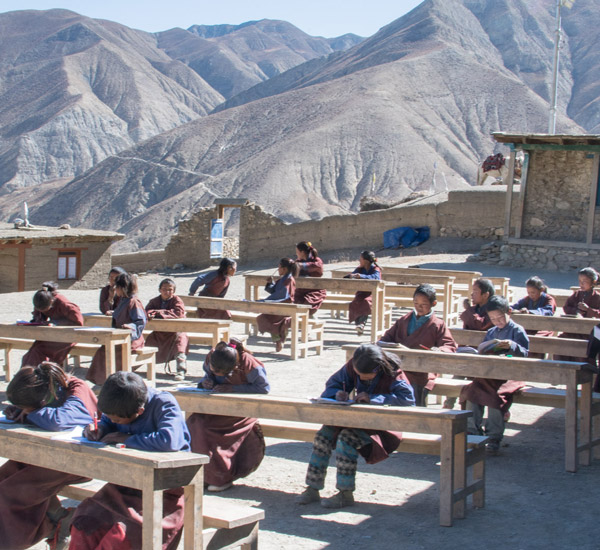
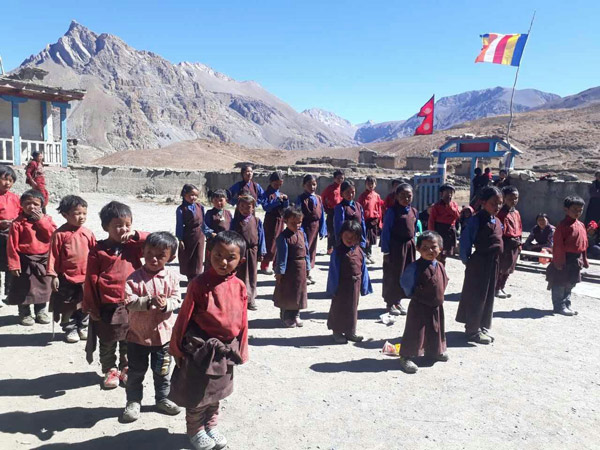
Komas School
$8,000 for the school at Komas (jointly funded with a group from Sweden and one generous German individual!)
For Komas in 2019 our support will be directed towards teacher salaries, student supplies and uniforms, as well as food supplies for school lunches.
Purchased foods would largely be rice and lentils to make dal bhat. Locally supplied foods would be yogurt, buckwheat (pancakes), barley (tsampa), potatoes and any other vegetables that can be grown, many in a greenhouse (greens, carrots, cucumber, cauliflower, cabbage and squash).
We have not been asked to help with any special projects for 2019, although that could change after I meet with the school coordinator in Dec of 2018.
Karang School
$20,000 for the school at Karang. This school has lost all other funding sources so we hope to provide a much higher level of support to them this year.
The infrastructure at this school is in good condition and they have a very good greenhouse. The greenhouse was built with funding provided by Sumchog Kersbergen, Yak Girl Dorje Dolma’s sister.
We also hope to provide several of their graduating students with scholarships to continue their education beyond grade 5. Pema Gojor Gurung, the school coordinator for Karang, has been working tirelessly to find funding for a hostel in Kathmandu and to qualify his students for discounted school fees at the Tibetan exile school where Altitude Project currently supports Tenzin Norbu.
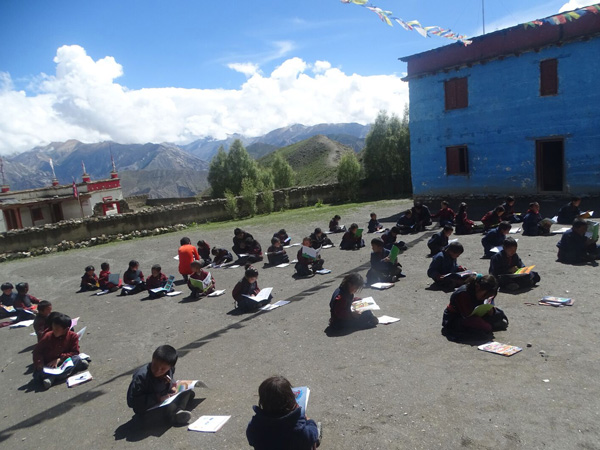
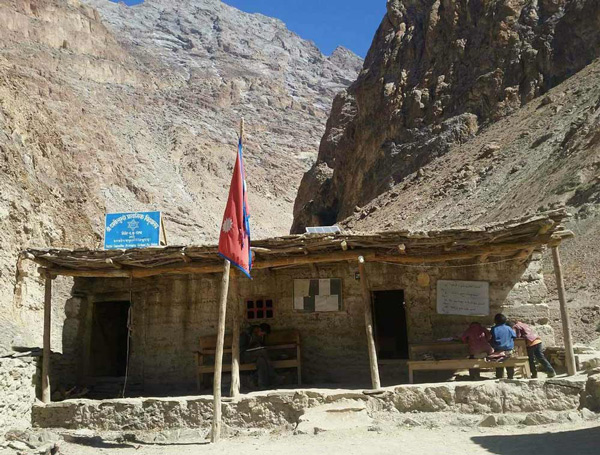
Ku School
$2,000 for the school at Ku as another one-time grant. This extremely remote school was brought to our attention earlier this year by Peter Werth, a philanthropist who works building sustainable energy and water projects throughout the Upper Dolpo. We were able to provide a grant of $1,500. Together, with a variety of NGOs, we cobbled together enough funds to keep this school going in 2018.
In December we will be meeting with Pema Tsering Gurung, the coordinator of the school in Ku, to learn more about their needs.
Tenzin Norbu, Saldang Graduate
We will continue to support Tenzin Norbu as he enters class 9 at a Tibetan exile school in Kathmandu.
Saldang School only goes to class 6. The schools at Karang and Komas go to class 5. To continue their education, students must move to Kathmandu, the capital city of Nepal and a world away from the Dolpo. Please read more, these are truly amazing kids!
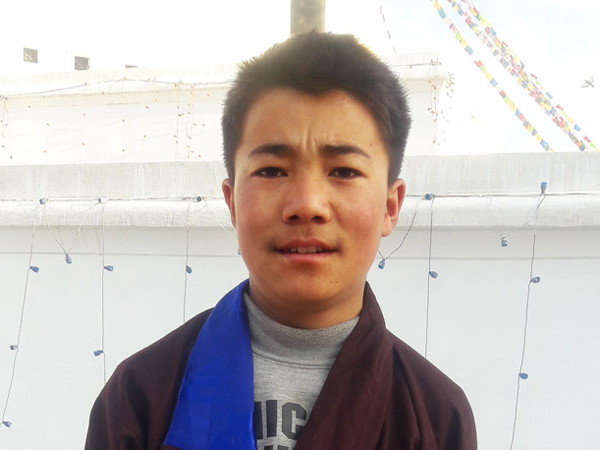
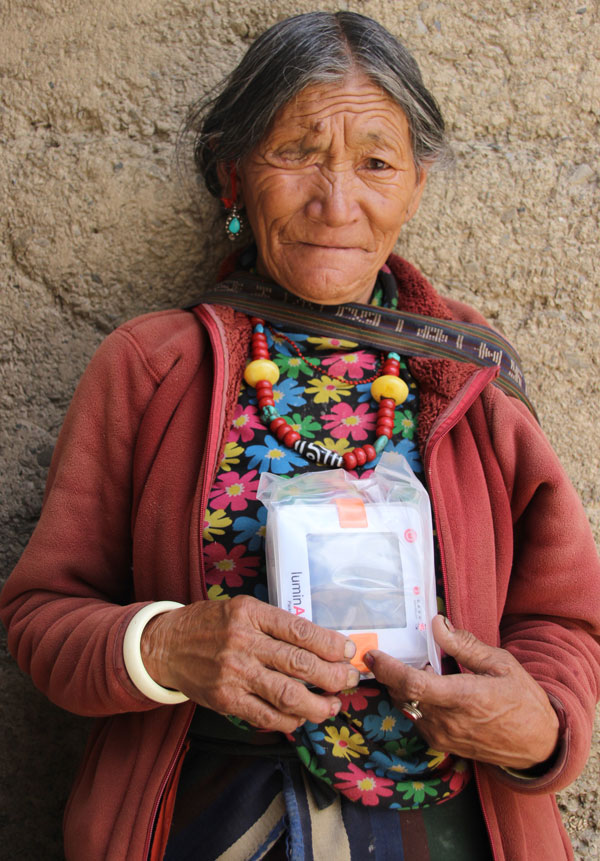
Purchase of 100 portable solar lights for villagers
$2,000 – to send more solar lights by LuminAID to villagers in the Upper Dolpo. Fire from yak dung or kerosene lanterns is the only light source for most households here and the resulting indoor pollution causes pulmonary and eye disease. These lights have proven to be extremely useful and durable; as a general light in the home, to travel to the toilet at night; to help students read and study in the evenings, and to visit neighbours. Most unexpectedly, they seem to keep snow leopards away from their animals at night when they are grazing them in their high mountain summer camps.
Many of the older adults suffer from very poor eyesight due to exposure to long hours of sunlight working in the fields at 14,000 feet elevation. (A doctor visiting with Nomad’s Clinic said “that when he looked into their eyes with an ophthalmoscope he rarely saw a “red reflex”—the red light bouncing off a healthy retina. Instead, he saw the opacity of eyes beginning to form cataracts from long exposure to the blazing sun of the high-altitude desert.”) They say these lights have really improved their quality of life.
For 2019, we have a request for 100 more lights, complete with names of individuals and their village location.
We are able to purchase these lights at a considerable discount for charitable purposes through LuminAID and offer very special thanks for their help!
REED
During 2018, the NGO REED – Rural Education and Environmental Development Centre Nepal, visited schools in the Upper Dolpo to assess the quality of education. Their survey showed there is great opportunity for improvement. Most project teachers are not professionally trained. They are people from the villages who completed high school, at minimum, in Kathmandu and have returned to help their villages as teachers.
REED has proposed a first phase training program in March of 2019 for a ten-day training session for 70 teachers. They will stop at Dunai in the Lower Dolpo for the training session as they make their way to the Upper Dolpo to open the schools at April 1. Eight NGOs will contribute to the training program at a cost of ~ $2,000 each. REED will follow-up the training session with on-site support to ensure teachers are implementing the practices learned during the training session.
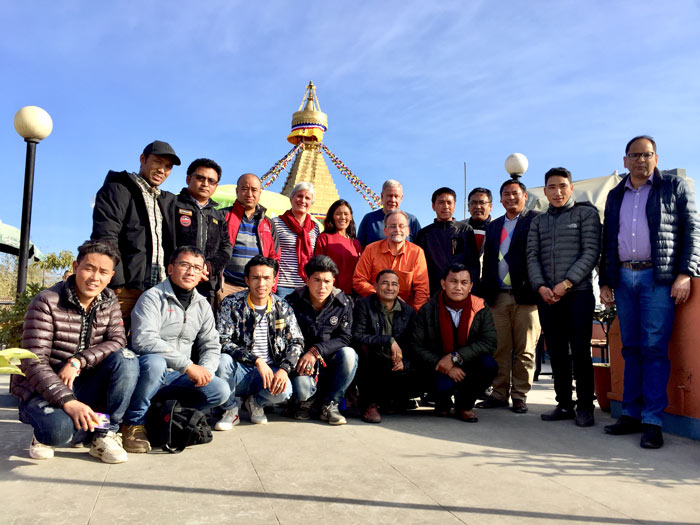
After our teacher training meeting with REED
It always seems impossible, until it’s done.
– Nelson Mandela.

